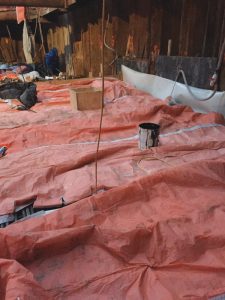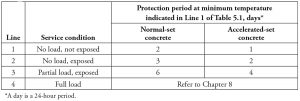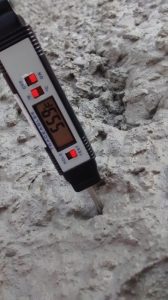Discussions of cold and hot weather concrete procedures do not occur until the five-day forecast calls for extreme weather. At that point, everything becomes a rush.
Special concrete mixes, as required, need to be submitted for approval at the beginning of a project. Time is required to test and practice with different temperatures and dosages and to adjust the cocktail of admixtures that form the basis of high-performance concrete today. The right time to discuss these procedures is in the Pre-Concrete Conference before placing the first yard of concrete. This ensures adequate time for the structural engineer, contractors, and concrete producer to properly coordinate and prepare for inclement weather conditions. At 70 degrees Fahrenheit, life is good. However, temperatures below 50 degrees and above 85 degrees require different concrete mixes and different weather related procedures. It is not just the cocktail mix or the temperature that is the variable. Traffic conditions, plant conditions, distance from plant to site, and finishes required all play a part in the determination of the correct concrete for a given structural element.
It is also important to note that each site is different. For example, even within the same city, a site that is near the concrete supplier may have different needs to achieve proper placement than a site that is farther away. As such, each site needs to have its own cold and hot weather concrete procedures. This should be submitted by the concrete contractor, in conjunction with the concrete plant and the various suppliers, for review by the engineer of record. High-performance concrete is very dependent on the source of the aggregate, its gradation, and continued availability. Delivery of the aggregate to the plant is also a consideration.
The ACI provisions most applicable to this topic are ACI 305 Guide to Hot Weather Concreting and ACI 306 Guide to Cold Weather Concreting. For more in-depth discussions of any of the items addressed in this article, these reports contain detailed information on the topics.
When Cold Applies
The definition of when to apply cold weather concrete provisions, per ACI 306, differs based on the ACI edition referenced by the applicable building code. Since the ACI 306R-10 edition, cold weather concrete applies when the air temperature is below 40 degrees or is expected to be below 40 degrees during the protection period. The protection period is defined as being between one and four days for concrete with accelerators mixed in (Table 7.1 of ACI 306).
Prior to ACI 306R-10, cold weather concreting was defined as “a period when, for more than 3 consecutive days, the following conditions exist: 1) the average daily air temperature is less than 40⁰F and 2) the air temperature is not greater than 50⁰F for more than one-half of any 24-hour period. The average daily air temperature is the average of the highest and lowest temperatures occurring during the period from midnight to midnight” (ACI 306R-99). The newer definition requires cold weather concrete procedures to be enforced more often.
Minimum Concrete Temperatures
ACI 306 provides recommended concrete temperatures as shown in Table 5.1 of ACI 306.
For a typical slab placement on a freezing day, the concrete needs to be at least 65 degrees while mixing and then needs to be maintained at 55 degrees once placed. For thicker elements, these temperatures are reduced as the exothermic reaction of the concrete itself generates additional heat. These temperatures should be maintained for the required protection period, as shown in Table 7.1 of ACI 306.
The temperatures and time periods for protection are to prevent damage to the concrete by early-age freezing of the water required for cementitious hydration.
Maintaining the required concrete temperatures during cold weather periods can be done in multiple ways. The most common methods used include:
- The use of hot water in the concrete mix
- The use of steam heated aggregate
- The introduction of an accelerating admixture
- Heating and tenting the area of concrete placement
More exotic methods include the introduction of a network of pipes that control the internal temperature of concrete by the flow of temperature-controlled water through this network. Depending on the ambient temperatures, only some or all of these methods are utilized. It is common for the accelerating admixture dosage to vary depending on the ambient temperature and other factors.
The concrete producer can provide a chart of accelerating admixture dosages for a given project, based on member size. Trowel finished slabs must be “normal setting.” A delayed set can result in surface drying that initiates the finishing process. Retarded setting can cause delayed bleed which leads to surface delamination.
Minimum Temperatures for Everything Else
ACI recommends that any surface that comes in contact with the concrete during placement should have a surface temperature above freezing. This includes reinforcement and formwork. ACI considers this a best practice. For “massive metallic embedments” (typically pipes, or wide flange beams), it is important that these embedded elements be heated before concrete placement to bring the element as close to the concrete temperature as possible. This avoids the potential of the metal locally causing the concrete to freeze and thereby locally reducing the bond strength.
Practical Field Issues
Even with the best planning, things can and do go wrong in the field. A member of the construction team needs to be constantly monitoring the concrete trucks and keeping an eye on things. For example, when trucks start backing up due to a broken pump or for any other valid reason, sending one or two trucks away from the site may mean that the next dozen trucks stay within specifications. Problems compound when they are not continually monitored.
It is imperative that the concrete temperatures of all trucks arriving at the site be constantly monitored. Assuming that if the first few trucks have temperatures within the specified limits, then the remainder of trucks should be acceptable, is not a good assumption and increases the risk of a possible failure. While temperatures typically rise as the day goes on, other external factors can reduce concrete temperatures. For example, a plant may only be able to preheat a certain amount of aggregate the night before. Once the pre-heated aggregate is used up, the next trucks would see a temperature drop which likely would not be sufficiently compensated by the slight increase in ambient temperature. Similarly, a plant may reduce the amount of accelerator in the concrete later in the day which can also reduce the concrete temperatures.
Accelerating admixtures should be properly dosed based on ambient temperatures and should be adjusted throughout the concrete placement if needed. The overuse of accelerators can result in concrete that sets before it is finished and can cause cold joints in the concrete.
As a general rule, if ambient temperatures are below freezing during concrete placement or the protection period, then some means of externally applied heat will almost always be required when placing slabs. This is often achieved by tenting and covering the concrete with thermal blankets and utilizing heaters. Direct heat should be avoided.
Freeze Resistant Concrete
As with all rules, there are always exceptions. Freeze resistant concrete is concrete that utilizes an accelerating admixture that allows for lower concrete temperatures at the time of placement. While these chemicals provide a slight increase in the cost of the concrete, they can significantly reduce some of the costs associated with external heat and other methods. Most manufacturers of admixtures have dosing tables which can be used as a baseline when beginning to implement a cold weather mix on site.
As exacting procedures of freeze resistant concrete are not yet included in ACI, testing of all mixes under field conditions (with field cured cylinders) is typically required to ensure that the concrete is reaching the proper required strength. Concrete placement with the correct, well-designed concrete mix in ambient temperatures as low as 15 to 20 degrees, without externally applied heat, is a fairly common practice on many projects.
Monitoring Temperatures
The temperature of the concrete must be monitored closely. When the concrete truck arrives at the site, the concrete temperature should be recorded immediately to make sure it meets the minimum criteria specified by the Structural Engineer of Record. The designated Special Inspector, an extremely valuable part of the process, must use a calibrated thermometer. It is recommended that spare calibrated thermometers be kept on site; nothing is more damaging than finding out that trucks were deemed non-compliant due to faulty equipment or the tester’s lack of knowledge in the use of testing equipment.
If the tester finds trucks beyond the range of the specifications, the plant needs to be informed immediately. This allows the plant to make corrections and adjust the design mix, thereby containing the number of trucks that arrive beyond the specification range. The concrete temperature should also be monitored when the concrete reaches the deck/point of placement. After placement, during the protection period, the concrete temperature must again be verified to ensure that the concrete remains at the minimum required temperatures.
A simple way to monitor these temperature changes is by using a calibrated maximum-minimum thermometer. Thermometers are available with a probe on one end that can be tucked under a blanket or in the concrete form. The probe tracks the approximate temperature on the concrete surface during curing. In addition to properly curing horizontal surfaces, required concrete cylinders need to be properly stored in an insulated curing box. During cold or hot weather days, the maximum-minimum thermometer can be used to monitor the temperature of the curing box. If there are low breaks during hot or cold weather, one of the first suspects is the curing method of the cylinders. By monitoring these temperatures, this concern is proactively eliminated. Checking the temperature of the concrete upon arrival, and then again in place in 45 to 60 minutes, gives the concrete team guidance on slump and setting time adjustments if needed.
(The above paragraph is an excerpt from “Ensuring Quality Concrete”(Alper, et. al), a Construction Issues article published in the June 2016 issue of STRUCTURE magazine.)
Hot Weather Concrete
Unlike Cold Weather concrete, the ACI Code does not provide specific temperature requirements for when hot weather concrete criteria apply. ACI 305 defines hot weather as any combination of conditions that “impair the quality of freshly mixed or hardened concrete by accelerating the rate of moisture loss and rate of cement hydration.” As a general rule, structural engineers in the Northeast require hot weather concreting procedures to commence when ambient temperatures exceed 85 degrees. This may vary based on location and other relevant conditions.
Maximum Temperatures
ACI 305R does not provide maximum temperatures for concrete during hot weather placement. The emphasis is on maintaining proper workability without affecting concrete strength. During hot weather, the rate of cement hydration and increased evaporation create issues with the workability of the concrete. The addition of water to the mix would typically mitigate these issues. Unfortunately, additional water also reduces the concrete strength, increases shrinkage, and causes additional cracking.
Maintaining the required concrete temperatures during hot weather periods can be done many ways without reducing the concrete strength. The most common methods include:
- The use of cold water in the concrete mix
- The use of ice in the concrete mix
- The use of water reducing admixtures (instead of using water on site)
- The addition of retarding admixtures and hydration set control admixture
- The use of fly ash and slag to reduce the cement content
- Cooling of the aggregate by sprinklering and shading
It is important for field personnel to ensure that cold joints do not form during concrete placement, as they can cause significant structural problems with the introduction of shear failure planes between the layers of concrete.
Practical Field Issues
A smooth continuous flow of work that constantly engages all personnel is something that every contractor strives for; that process maximizes efficiency and therefore increases profitability. The use of retarding admixtures, while excellent during the travel time from the plant to the site, delay when the concrete finishers can start their work. Accordingly, the careful calibration of the amount of admixture used as concrete placement progresses reduces setting times towards the end of a concrete placement. Whereas the idea is theoretically sound, there are as yet no metrics and no big data available to provide ground rules and basic parameters for this calibration. The result can be problems for workability and cold joints. While it is not unreasonable to reduce the admixture dosage, it still is a judgment call based on the structural engineer’s and contractor’s experience; it needs to be done in a cooperatively controlled manner.
Placing concrete at reduced ambient temperatures, such as night placements, can significantly ease the problems related to hot weather concreting.
Mass concreting during hot weather can be extremely challenging and is the scope of a future article.
Proper curing is extremely important to reduce cracking. The use of foggers and wet burlap are effective ways to cure slabs. Slabs that are not properly cured can exhibit significant cracking. This cracking is more pronounced on slabs that are restrained on the ends, such as a ground floor slab restrained by the foundation walls.
As cold joints are more prevalent when the concrete sets faster, consider the addition of preformed construction joints within the slab, even when the slab is scheduled to be placed in a single day. This allows the concrete placement to be stopped at strategic locations without compromising the integrity of the slab. If the construction joints are not needed, they can simply be removed during the placement before the concrete reaches that area.
Monitoring Concrete Temperatures
The monitoring of concrete during hot weather is similar to that of cold weather concrete. In addition to monitoring temperatures, the monitoring must include oversite to ensure that cold joints do not form.
Conclusion
As with everything in construction, a smooth and continuous flow of operations is the difference between a project being successful and profitable or otherwise. With proper planning and execution, quality concrete can be placed under almost any inclement weather conditions. The use of heated/cooled materials, properly dosed admixtures, and effective curing of the concrete are critical in making sure that the concrete placement is setup to succeed.▪




